Google Chromecast Review - An Awesome $35 HDMI Dongle
by Brian Klug on July 29, 2013 9:45 PM EST- Posted in
- Smartphones
- Media Player
- Android
- Mobile
- HDMI
- Chrome
- Tablets
- Chromecast
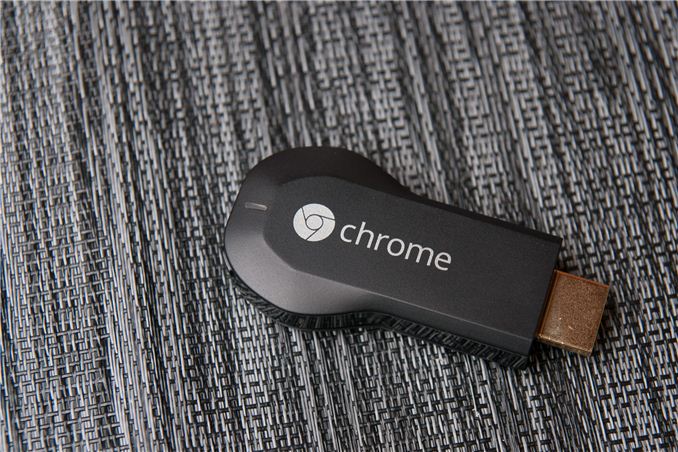
So I have a confession to make – I didn’t hate the Nexus Q. While I didn’t necessarily love it and use it daily like a small minority of my peers did, I also didn’t immediately declare the product an unmitigated disaster like the vast majority of people. The fate of that product was so quickly decided that I hadn’t even begun writing my review when the whole thing was terminated. When I spoke with Googlers about Nexus Q, what was obvious to me was that the Q had begun as an audio-only product that later on had HDMI added, and that tiny bit of context made all the difference in understanding the choices behind it. I left the Nexus Q plugged into my AV Receiver up until the most recent set of Google Play apps killed functionality entirely.
Ultimately the price of the Nexus Q was its undoing ($299), not necessarily its functionality or even its somewhat awkward spherical form factor. The concept was relatively sound – a network-attached appliance that played back movies and music from Google’s servers directly, rather than streaming them from device to device on the same network. The Q ran Android 4.x atop an OMAP4460, literally the same platform as the then-flagship Galaxy Nexus, just sans cellular connectivity, which made it a logical choice.
The Nexus Q was killed off before other services could be added, but at a high level the Q’s functionality as a playback device rather than streaming endpoint carried onto its successor, the Chromecast.
The Chromecast is obviously everything the Q should’ve been. It’s a simple, small, $35 HDMI dongle, powered by USB, that’s designed to discreetly plug into the back of a TV. There’s been much talk about the power requirement of the Chromecast, USB is indeed required for operation, but just about every modern TV has USB ports on the side for attaching mass storage or powering accessories like this. In fact, the Chromecast’s form factor is already a popular one for Android-powered HDMI dongles and Miracast sinks, as well as a variety of other small appliances. I’ve confirmed with Google that MHL-HDMI is not in fact supported by the Chromecast, meaning it can’t be powered by a TV that includes the spec (which can deliver up to 500 mA at 5 V), straight HDMI can only supply 50 mA at 5V. I’ve yet to encounter a TV with MHL-HDMI myself, including on the 55-inch LCD TV I purchased just 3 months ago.
Inside the box for the Chromecast is the device itself, a relatively long microUSB cable, USB power supply, and HDMI extender. Funnily enough the USB power supply appears to be the exact same as the previous generation Motorola USB charger (5V, 850 mA), just with a different exterior – is this the first Motorola product out of Google proper?
The HDMI extender cable helps get the Chromecast behind a TV if you need to turn it 90 degrees or have an inset port with inadequate clearance like I do on my front-facing HDMI accessory port.
There’s not much to talk about regarding aesthetics of the Chromecast itself, it’s a dongle with a rounded bulge at one end, and HDMI port at the other. There’s a reset button on the side, microUSB port for power, and a status LED on top. On the bottom are regulatory markings. My only complaint about the Chromecast’s design is this status LED, which inexplicably is bright solid white whenever the device is on, making it distracting in a dark living room or bedroom. Nothing electrical tape can’t solve, but an inexplicably poor choice for a media center playback device given that bright LEDs are a known no-no.
The hardware is what it needs to be – small, simple, and conducive to the low price point. The Nexus Q was a solid bowling ball in comparison, primarily thanks to the analog audio amplifier and hardware it really didn’t need. By keeping unnecessary I/O to a minimum the Chromecast ends up being a nice and small streaming appliance.


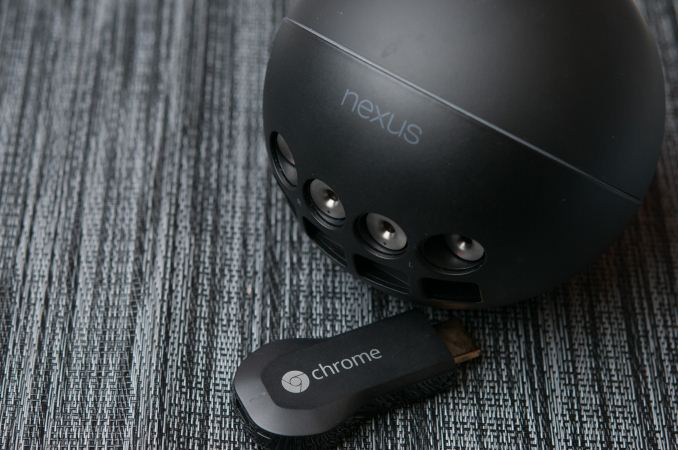
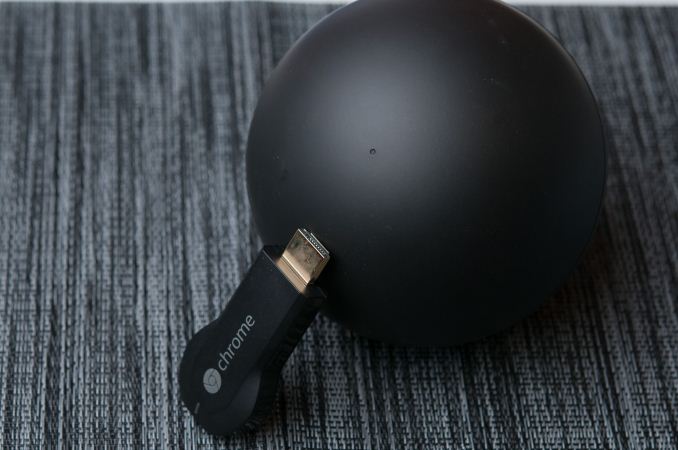

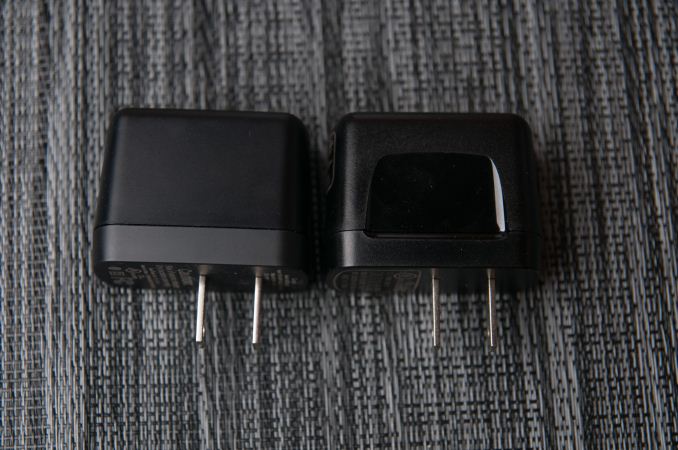






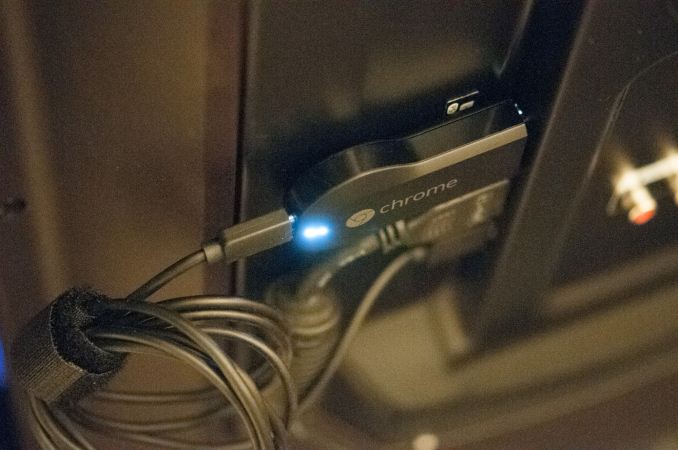








105 Comments
View All Comments
savagemike - Tuesday, July 30, 2013 - link
You have to realize there is a broader market for this stuff then straight up geeks. Half the population is using smart phones - which doesn't even say anything about tablet usage. How many of that set do you think also has a media collection on dlna servers? You think that is about half the population?This simply might not be a product directed at you.
Also it is probably a matter of weeks before plex has this enabled. I would imagine by Christmas there will be several avenues available for media geeks with home collections to use chromecast. And that is completely aside from the mirrored screen casting features.
mitcoes - Tuesday, July 30, 2013 - link
Thanks for the article. Excellent first version of this product but as I decided not to be more an early adopter I'll wait for the Chromecast 2 or 3 with all the features it should have the first version.As WiFi 5Ghz VP9 hardware decoding ethernet, Miracast 1080p or even 4k mentioned here - artilce + comments - . The price is the best.
And If I where a TV brand I would put inside my models something compatible - same software - but with this better features I wrote before as it seems this time Google TV is betting to be the new TV standard with or without chromecast and as we know standards - even if they are worse - usually win
ThortonBe - Tuesday, July 30, 2013 - link
Love the Grasshopper screen shot.rDeck - Tuesday, July 30, 2013 - link
"After spending a week tearing my hair out over Miracast (which frankly has the worst interoperability in the entire industry)"Could you provide some insights on your experience with the bad interoperability of Miracast?
I would be interested, because so far only very few devices are certified for Miracast, but those which are certified worked quite well for me until now...
rDeck - Tuesday, July 30, 2013 - link
Oh, except that Samsung "AllShare" dongle I just remembered. They somehow upgraded the firmware of it to support Miracast somehow, but despite having it certified, they officially don't really support Miracast...Popolon - Tuesday, July 30, 2013 - link
You can find the same kind of device by chinese maker, called something like 'miracast keys' for $10 or a little more since few month. Google only rebranded them and rise a little the price.amicrozen - Tuesday, July 30, 2013 - link
Thanks for the detailed review so quickly.Google is on the right track, but I will wait for it to mature.
zepi - Tuesday, July 30, 2013 - link
So this is googles Nth attempt to own content distribution channel over internet to peoples TV sets. Q and google tv etc...They seem to want it real bad.
YellowWing - Tuesday, July 30, 2013 - link
Brian - You might try adding the Google version of the Chrome Remote Desktop extension to get full screen going. I would definitely give it a try.relentlessfocus - Tuesday, July 30, 2013 - link
Not a biggie but its a shame it doesn't support 5ghz wifi. Slightly complicates things for those of us who have escaped 2.5ghz limitations